Since 2005, more than half of issued patents in the United States have been for software-related inventions. In AI, this trend continues to accelerate, with the global number of granted AI patents rising by 62.7% from 2021 to 2022. For small-to-medium size enterprises (SMEs), staying informed about this growth is crucial for maintaining a competitive edge with their intellectual property (IP).
Intellectual Property Ontario (IPON) published a 2024 patent landscape report to support SMEs in managing and commercializing AI patents in Ontario. Here are three key takeaways to help understand the global AI patent landscape, based on IPON'S 2024 AI Patent Snapshot Report (2024).
Growing AI Sectors
Although AI technology contributes to many rapidly growing fields, not all sectors are growing at the same rate. In fact, approximately 70% of total AI patent families are directed towards one of the sectors below:
- Medical and Life Sciences: AI solutions are spurring significant growth relating to drug discovery and diagnostics.
- Cyber and Network Security: AI-driven solutions are being developed to detect, prevent, and respond to cyber-attacks, enhancing the security landscape. This is in response to increasing connectivity and a rising number of cyber threats.
- Education: Online courses, auto-grading systems, and other AI-driven tools are transforming how education is delivered and consumed, making learning more accessible on a global scale, and tailored to individual needs.
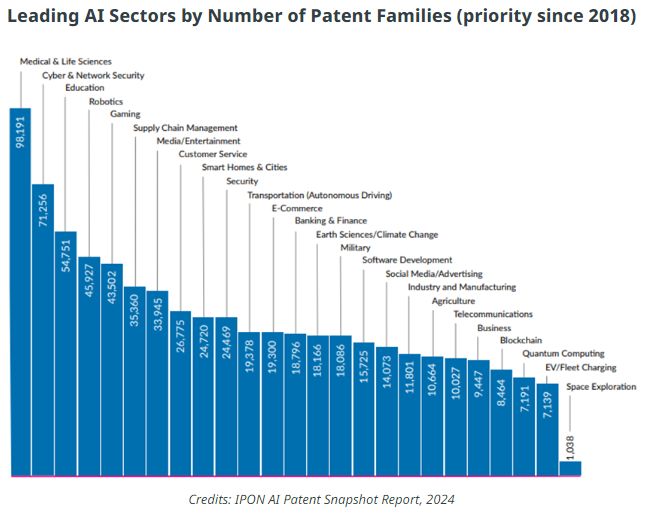
Popular Applications of AI Technology
While AI can be applied to a variety of domains, decision-making AI continues to dominate the landscape.
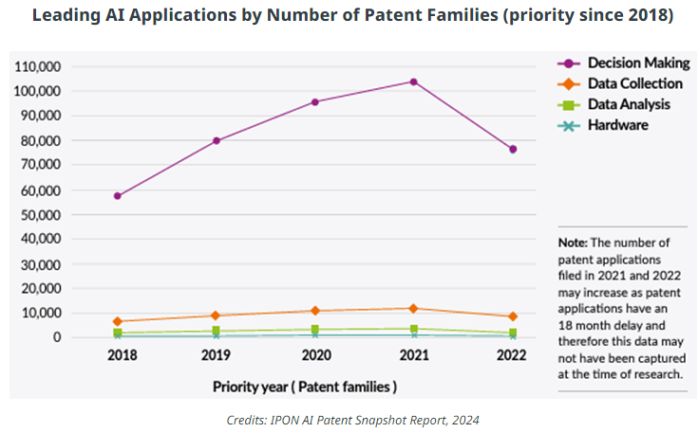
Top AI technologies
- Neural Networks: At the heart of many decision-making AI models, these systems mimic the human brain's ability to learn and make decisions. Neural networks are particularly useful in image recognition, behavioural data analytics, and medical diagnostics.
- Functional Applications: These use AI to complete tasks automatically, facilitating automated decision-making, planning, and problem-solving. They are especially useful in the customer service and education sectors.
- Classical Machine Learning: These models are best for well-defined tasks with structured data. Statistical algorithms are used for classification and prediction problems in areas such as banking/finance and medical/life sciences.
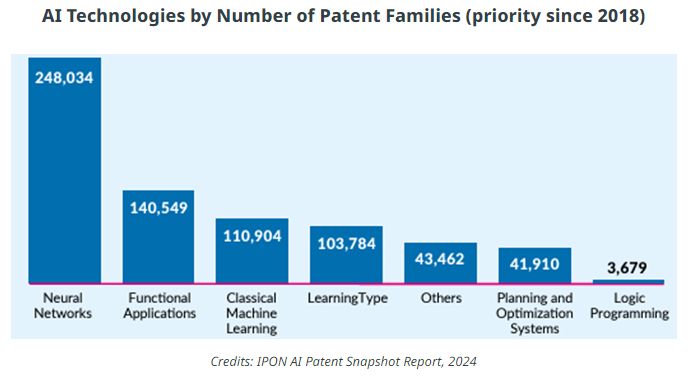
In addition to these extremely popular AI technologies, there are also several emerging technologies to keep an eye on. Applications of Spiking Neural Networks (SNNs), Transfer Learning, and Federated Learning, are trending in the AI patent landscape.
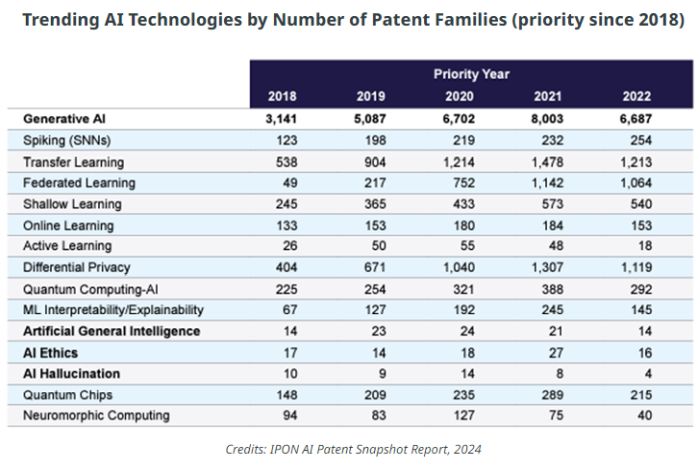
Key Players in the AI Patent Landscape
Global Leaders
China has emerged as a dominant force in AI-based IP. Driven by robust collaboration between universities, tech giants, and government organizations, their 2017 national strategy includes investing billions of government dollars in AI-related research. Their goal is to bolster the industry to a value of USD $150 billion by 2030.
The United States is another leader, accounting for about 21% of AI patents in 2022. Tech giants like Microsoft® and Google® are major contributors to this output, however, the country's global share of AI patents has decreased from a 54% share in 2010.
Europe has become a patent filing leader through robust regulatory frameworks and streamlined patenting procedures. The European Patent Office was one of the first to publish clear guidelines for patenting AI inventions, an area where other countries continue to struggle.
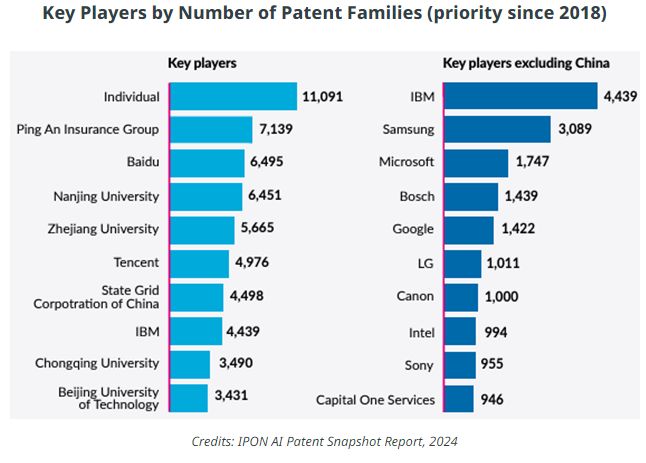
Despite some clear leaders in holding AI patents, the top 10 entities account for only 12% of global AI patent filings. This demonstrates a diverse and distributed innovation landscape.
AI Investors
The explosion of generative AI language models, such as ChatGPT and Gemini, has driven investors to channel billions of dollars into generative AI research and development. From 2022 to 2023, investment reached $25.2 billion, benefiting several major players, like OpenAI and Anthropic, as well as many well-funded startups.
These investments come with the expectation that tech companies will monetize their technology and generate substantial returns. To achieve this, leading companies will prioritize patenting their AI-based IP. AI patents secure exclusive rights to the technology and reassure investors that their investments are safeguarded against competitors. As investment in AI grows, we expect to see a global increase in AI patent filings.
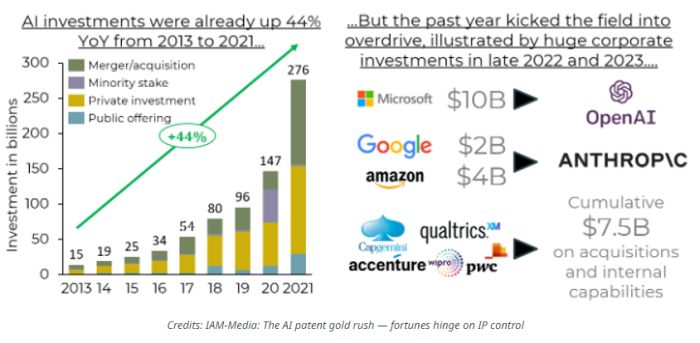
5 Key Takeaways
- With more than half of the AI patents being filed in China, this jurisdiction could be a crucial part to your patenting strategy and freedom to operate in China.
- While some countries struggle to outline patentability criteria for AI technologies, the EPO published clear AI and ML guidelines, which could make it easier to obtain AI-based patents in Europe.
- The surge in funding for generative AI models highlights the value placed on these technologies and potential to generate huge returns for investors from the AI-based IP.
- Also, consider whether your goal is patent ownership or patent leadership. Patent leadership requires distinguishing yourself from potential competitors, which is difficult in a patent space that is already crowded. There may be more opportunities if you prioritize areas with patent "whitespace" – application areas that are lightly patented relative to strategic importance.
- Comparatively, if patent ownership is your goal, saturated patent spaces are good indicators of high-demand innovation sectors. This might translate to more funding programs, collaboration opportunities, and future clients.
Understanding the evolving AI patent landscape is crucial for SMEs to stay competitive and to grow. Patent landscaping is a valuable tool for guiding IP decisions, and reports like IPON's can offer valuable insights.
The content of this article is intended to provide a general guide to the subject matter. Specialist advice should be sought about your specific circumstances.


